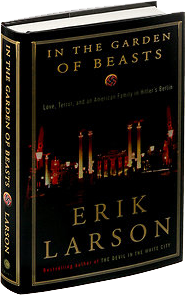The Author
This year, Fort Collins Reads is proud to announce Erik Larson, bestselling author of "The Devil in The White City", and "In The Garden of Beasts".
Erik Larson is the author of four New York Times bestsellers, most recently In the Garden of Beasts: Love, Terror, and an American Family in Hitler's Berlin, which hit #1 and remained on the printed list for 35 weeks. It was published in Britain, France, Italy, Poland, Australia and a number of other countries.
Larson is a marvelous writer...superb at creating characters with a few short strokes. --New York Times Book Review
A film adaptation of "In The Garden of Beasts" is currently in production. Erik's book The Devil in the White City remained on the Times' hardcover and paperback lists for a combined total of over three years. It won an Edgar Award for nonfiction crime writing and was a finalist for a National Book Award.

Erik graduated summa cum laude from the University of Pennsylvania, where he studied Russian history, language and culture. He received a masters in journalism from Columbia University. After a brief stint at the Bucks County Courier Times, Larson became a staff writer for The Wall Street Journal, and later a contributing writer for Time Magazine. He has written articles for The Atlantic, Harper's, The New Yorker, and other publications.
Larson lives in Seattle with his wife and three daughters.
The Book
The time is 1933, the place, Berlin, when William E. Dodd becomes America's first ambassador to Hitler's Germany in a year that proved to be a turning point in history.

A mild-mannered professor from Chicago, Dodd brings along his wife, son, and flamboyant daughter, Martha. At first Martha is entranced by the parties and pomp, and the handsome young men of the Third Reich with their infectious enthusiasm for restoring Germany to a position of world prominence.
Utterly compelling... Marvelous stuff --Washington PostEnamored of the "New Germany", she has one affair after another, including with the suprisingly honorable first chief of the Gestapo, Rudolf Diels. But as evidence of Jewish persecution mounts, confirmed by chilling first-person testimony, her father telegraphs his concerns to a largely indifferent State Department back home. Dodd watches with alarm as Jews are attacked, the press is censored, and drafts of frightening new laws begin to circulate. As that first year unfolds and the shadows deepen, the Dodds experience days full of excitement, intrigue, romance and ultimately, horror, when a climactic spasm of violence and murder reveals Hitler's true character and ruthless ambition.
Remarkable... Larson has done it again --Assosciated Press
Suffused with the tense atmosphere of the period, and with unforgettable portraits of the bizarre Goring and the expectedly charming--yet wholly sinister--Goebbels, In the Garden of Beasts lends a stunning, eyewitness perspective on events as they unfold in real time, revealing an era of surprising nuance and complexity. The result is a dazzling, addictively readable work that speaks volumes about why the world did not recognize the grave threat posed by Hitler until Berlin, and Europe, were awash in blood and terror.
Harrowingly suspenseful --Vogue
Other Titles By Erik Larson
-
The Devil In The White City
The No. 1 New York Times bestseller about the architect who led the construction of the great Chicago World's Fair of 1893, and the prolific serial killer who used the fair as a lure. Just blocks from the fairgrounds, the killer built a hotel of horrors equipped with an acid vat, dissection table and crematorium.
-
Thunderstruck
The saga of how the lives of the inventor of wireless and of Britai's second most famous murderer (after Jack the Ripper) intersected during one of the greatest criminal chases of all time. The inventor was Guglielmo Marconi, the young Italian genius; the killer was Hawley Harvey Crippen, who murdered his overbearing wife and fled Britain with his mistress, unaware that Scotland Yard was hot on his heels. The book -an instant New York Times bestseller-brings to life a host of forgotten characters, including spirit mediums, ghost-hunting physicists, Scotland Yard inspectors, and one of the great pioneers of forensic science. The climax occurs during a trans-Atlantic chase which, thanks to the miracle of Marconi's invention, was followed by millions of people around the world-with Crippen and his mistress completely unaware.
-
Issac's Storm
At the turn of the last century, Isaac Cline, chief weatherman for Texas, believed no storm could do serious harm to the city of Galveston, a fast growing metropolis on the Gulf Coast destined for great things. In September 1900 a massive hurricane proved him wrong, at great personal cost. The storm killed as many as 10,000 people in Galveston alone, stole the city's future, and caused hurricane experts to revise their thinking about how hurricanes kill. The book won the American Meteorology Society's prestigious Louis J. Battan Author's Award. (For the record, of all my books, this is my wife's favorite--EL.)
-
Lethal Passage
"When I lived in Baltimore, I became struck by the frequency of drive-by shootings involving young teens who possessed sophisticated weapons. At the time, no one bothered to find out where the guns came from. I decided to try. The result was this book, which tells the story of how a particular model of handgun, designed initially for urban warfare, became the crime-gun of choice for inner-city gangs, and how one such gun came to be in the hands of a Virginia schoolboy who used it to kill a teacher. Only a malfunction in the weapon prevented this incident from becoming one of the worst mass murders of all time.
In the course of my research, I became a federally licensed gun dealer and took lessons in shooting for self-defense. I have to say, the shooting was a lot of fun, although I was the only guy in my class and the gleeful laughter of the women around me, as they blasted away at clearly masculine targets, was just a tiny bit disconcerting."
-
The Naked Consumer
"After receiving a sudden surge of junk mail directed at new parents-even though my wife at the time was merely pregnant-I set out to explore the lengths companies go to spy on individual consumers. It was fascinating, and a little scary. For example, I discovered one market-research firm that put human spies in stores to follow every move a shopper made, and another company that secretly commandeered viewers' televisions to show them commercials no one else got to see. The book became the subject of a PBS documentary, 'We Know Where You Live,' in which yours truly was the main character. I even got to slink around in a trench coat and lurk behind trees."
Questions to Think About
- Why do you think Ambassador William Dodd's warnings about Hitler were meant with indifference in the United States?
- Did anti-Semitism in America play a role in dismissing the chorus of concerns?
- Was the U.S. stance on Hitler one of purposeful ignorance or sheer disbelief?
- How did your knowledge of the way history actually unfolded in Nazi Germany affect the way you experienced the book?
- Does Erik Larson humanize Hitler or present him as a monster?
- What did you learn about the time period that surprised you?
- What fueled Martha's romantic views of Nazi Germany?
- What fueled the general public's adoration of Hitler?
- What does the book reveal about human nature?
- What parallels exist between then and now?






